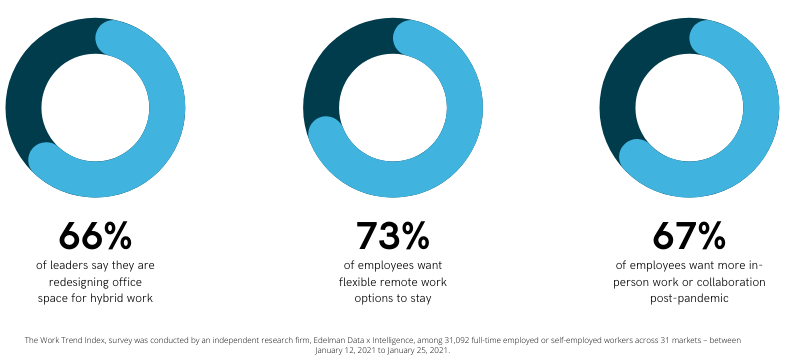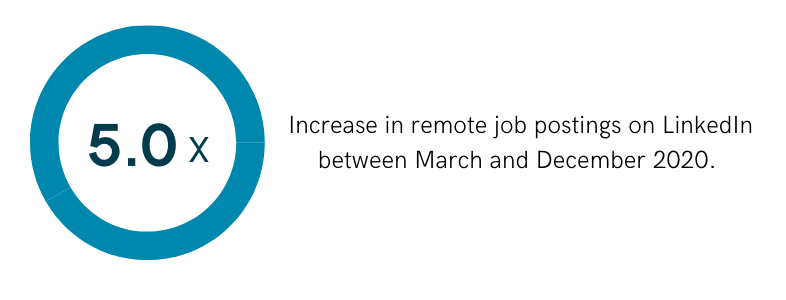
The benefits of Hybrid Working
If the past year has taught us anything, it’s that how we work is far more important than where we work from. Across the globe, remote working has become the norm and it’s opened up a plethora of opportunities for the modern workplace. Which, by the way, will undoubtedly be hybrid.
Hybrid Working is on the rise and with an end to the COVID-19 pandemic in sight, we’ve already seen an uplift in businesses adapting to this way of working. One such example is that of Nationwide, the UK’s largest building society who recently told 13,000 of their staff to ‘work anywhere’. And they’re in good company. The Work Trend Index: 2021 Annual Report, found that:

So, what exactly is the Hybrid Workplace and Hybrid Working?
Apart from being a slick sounding buzzword, the Hybrid Workplace is a business model that’s geared towards the need for increased flexibility in modern business. It’s by no means a new concept; however, it has become increasingly relevant as more and more businesses plan their post-pandemic way of working.
Hybrid Working allows some employees to work remotely, be that in a coffee shop or at home, while others work on-premises. Having your cleaning staff work from home probably isn’t the best idea, however, other teams such as Development and Marketing could greatly benefit from this model.
“Over the past year, no area has undergone more rapid transformation than the way we work. Employee expectations are changing, and we will need to define productivity much more broadly — inclusive of collaboration, learning, and wellbeing to drive career advancement for every worker, including frontline and knowledge workers, as well as for new graduates and those who are in the workforce today. All this needs to be done with flexibility in when, where, and how people work.” – Satya Nadella, CEO at Microsoft
The benefits of Hybrid Working
While there are several factors to consider before implementing Hybrid Working, such as technology, the nature of your work and the socioeconomic factors that may inhibit your workforce’s ability to work from home, Hybrid Working carries significant benefits when implemented correctly.
1. Improved productivity
A well-structured Hybrid Workplace creates a culture that empowers employees to work to their strengths. Through increased flexibility and independence, employees have the freedom to work when and where they are most productive. Employees will be able to experience the best of both worlds by using the office for scheduling on-premises days for meetings and collaboration, and remote days for tasks that require focus.
In an interview with BBC, Baruch Silverman, founder of personal finance website The Smart Investor, said: “We try to use home working days less for video sessions and more for the tasks that require concentration. A task that may take several hours in the office may be completed in just an hour or two at home.”
“We try to use home working days less for video sessions and more for the tasks that require concentration.” – Baruch Silverman, founder of The Smart Investor
2. Increased employee wellness and satisfaction
Mental wellness
Hybrid Working grants employees the ability to structure work around the rest of their lives, not the other way around. It removes the stress of everyday commuting and allows employees to work without the pressure of only being able to tend to non-work-related commitments when they get home after a long day at the office.
Physical wellness
Working from home provides people with disabilities or medical conditions the chance to work comfortably while staying connected. Having a more flexible working schedule allows employees to accommodate healthy eating habits and a regular exercise routine. You’re also able to decrease health exposure risks. Fewer in-house employees mean you’re able to lower the risk of colds, flu, or any other illnesses spreading around the office.
3. Remove geographical restrictions when recruiting new talent
Removing geographical restrictions allows businesses to access larger talent pools by leaning on remote work as a permanent fixture of talent acquisition. The Work Trend Index: 2021 Annual Report found that Forty-six percent of remote workers are planning to move to a new location in the next year because they can now work remotely. The report also noted that remote job postings on Linkedin increased more than 5 times between March and December 2020. By recruiting nationally (or even globally), you’re able to build teams with rich cultural and experiential diversity as well as capitalise on time-zone differences. Thus, allowing you to offer 24/7 customer support or the ability to bring in some extra brainpower during peak business hours.

Become an attractive forward-thinking employer
Less geographical restrictions mean more opportunities for jobseekers. Gone are the days where you could attract and retain talent by simply offering them a flashy salary. As we start transitioning to the new way of working, employees will come to expect flexibility and consideration towards their well-being. It’s therefore crucial that you position yourself as a forward-thinking employer by having the right technology and an effective hybrid working strategy in place.
4. Cost savings
With a flexible workforce, the need for fixed office space changes – allowing you to make significant savings on costly overheads such as electricity and rent. It’s common practice among hybrid companies to have a small office space for on-premise staff and separate meeting rooms and hot-desking areas for employees with irregular working patterns. These working areas may be situated in-house or rented from shared workspace companies like WeWork.
5. Be prepared for an uncertain future
The COVID-19 pandemic has shown us that life as we know it can be flipped upside down in an instant, which is why it’s crucial that businesses remain agile and prepared for change. The Hybrid Working model empowers you to do this by already having the right technology, structure and employees in place to adapt to unexpected circumstances.
Conclusion
While there is still a lot of uncertainty about the future of work, there is also a massive opportunity for forward-thinking businesses to get a better handle on employee well-being and productivity, while benefiting from the cost efficiencies of Hybrid Working. Now is the perfect time for organisations to establish their Hybrid Working strategy and take advantage of the significant cost savings of diverting spend from physical assets to technology. As is always the case, the businesses who fully embrace change with a growth mindset are the ones who will develop a better workplace for everyone.